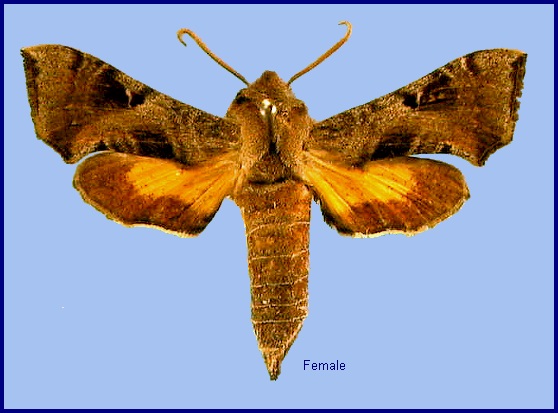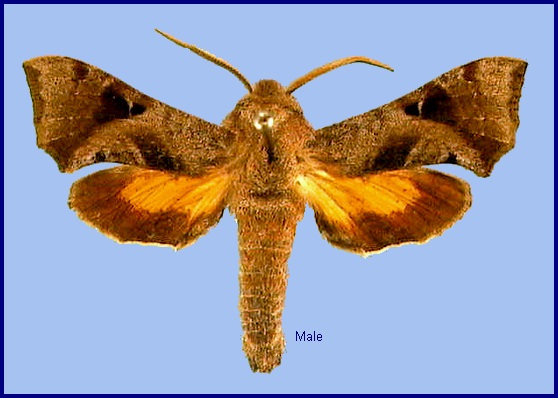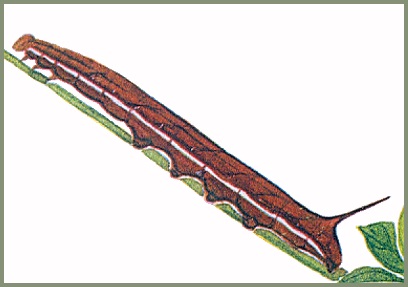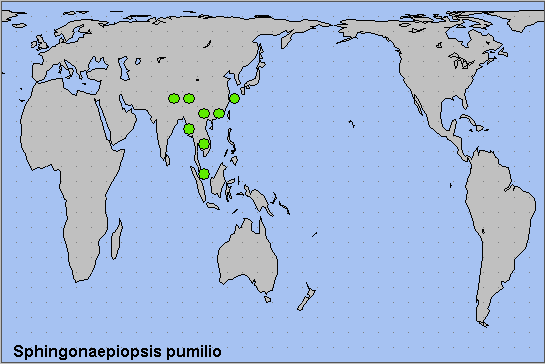

Lophura pumilio Boisduval, [1875] 1874, in Boisduval & Guenée, Hist. nat. Insectes (Spec. gén. Lépid. Hétérocères) 1: 311. Type locality: [Bangladesh,] Sylhet.
Synonym. Oenosanda chinensis Schaufuss, 1870.
Synonym. Lophura pumilio Boisduval, [1875] 1874.
Synonym. Lophura pusilla Butler, 1875.
Synonym. Lophura minima Butler, 1876.
Wingspan: 27--31mm. Body and forewing much more brown than either Sphingonaepiopsis gorgoniades gorgoniades or Sphingonaepiopsis kuldjaensis. Hindwing upperside orange-yellow, with brown marginal band of nearly even width, not tapering as in Sphingonaepiopsis kuldjaensis. Abdomen upperside without three pairs of white lateral spots (unlike Sphingonaepiopsis gorgoniades gorgoniades).
In the male genitalia, uncus compressed, sharply pointed. Gnathos pointed. Valve strongly narrowed in apical half, almost pointed, longitudinally grooved along the dorsal edge. Harpe broad, densely covered distally with long spines that lie flat upon the harpe except for a few at the apex. Phallus without armature, or with a short, transverse, subapical ridge, bent proximad.
The moth rests in the same attitude as species of Neogurelca (Bell & Scott, 1937).
A crepuscular species. Attracted to the flowers of Duranta erecta.
China: viii (Fujian; Guangdong); ix (Jiangxi); 12.ix-19.x (Hong Kong); 15.ix (Anhui).
Three annual generations are recorded for Hunan (Lin & Lei, 2008).
OVUM:
LARVA: Full-fed 40mm, width 6mm, horn 6mm. According to Bell & Scott (1937), in the final instar head nearly round; true clypeus more than half the length of head, apex narrowly rounded, basal angles not rounded; false clypeus forming a gothic arch over apex of true clypeus, apex nearly reaching vertex of head; labrum about one-third length of true clypeus; ligula kidney-shaped; mandible with the cutting-edge toothed. Surface of head dull and smooth; labrum minutely, longitudinally lined. Body dull and smooth, nearly cylindrical, tapering very slightly from segment 5 frontad. Horn short, straight, thick at base, and tapering evenly and sharply to a blunt point; covered with small tubercles directed distad.
Colour very variable. Head and body may be green, yellowish-green or greyish-yellow in the pale-coloured forms; but reddish, chocolate or very deep-brown in the dark-coloured forms. In the pale-coloured forms the head is immaculate; body with a more or loss distinct, reddish-brown dorso-lateral stripe widening into dorsal patches on the posterior half of the body. A broad, well-defined, white subspiracular stripe runs from segment 2 to 14; and there is an encircling row of white dots around each secondary ring. In the dark-coloured forms the head has a pale stripe from vertex to base of antenna; the body has the white subspiracular stripe and sometimes a black dorsal stripe with a pale stripe on each side of it on segments 2 and 3; venter paler. Spiracles white with a black or dark-coloured band across the middle, and a narrow, raised, black rim (Bell & Scott, 1937).

PUPA: 20mm, width 6mm. Colour honey-yellow; head and thorax broadly barred with black; legs, antenna and each half of tongue outlined black; wing-case suffused with black, leaving the veins narrowly yellow. Each segment outlined thickly with black, with two black transverse bars on each abdominal segment. Front bevels of segments 8 to 10 ochreous, hind bevels black spiracles and cremaster black (Bell & Scott, 1937).
Stout in build, head narrowing frontad and then rounded; antenna slightly longer than fore leg; there is a large coxal piece. Surface shiny; head, thorax and wing-case very superficially irregularly lined; abdomen sparsely, coarsely pitted; segment 9 with nine parallel ante-spiracular ridges. Spiracle of 2 a narrow slit, the front margin of 3 slightly thickened behind it; other spiracles oval, flush. Cremaster a short cone with a blunt tip (Bell & Scott, 1937).
Pupation takes place in a rough cocoon on the surface, and in captivity among leaves of the hostplant or in the upper corners of the box in which they are kept.
Larval hostplants. Recorded in Guangdong on Galium gracile and Oldenlandia (Mell, 1922b), on the garden plant Serissa japonica [syn. Serissa foetida] in Hunan (Lin & Lei, 2008), and on Hedyotis uncinella in northeastern India (Bell & Scott, 1937).
Unknown.
China: Anhui; Shanghai; Zhejiang; Hunan (Hengyang); Jiangxi (Guangfeng; Nankeng Town, Pingxiang); Fujian (Xiamen); Guangdong (Jiufeng, east of Nan Ling); Hong Kong (Lantau); Hainan (Haikou).
From Uttar Pradesh, India, east through Nepal, Bangladesh and Burma/Myanmar to China (as far north as Anhui), and south to Peninsular Malaysia through Vietnam and Thailand.

Northern Oriental.
 Return to Sphingidae of the Eastern Palaearctic species list
Return to Sphingidae of the Eastern Palaearctic species list